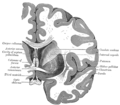| Septum pellucidum | |
|---|---|
 Image showing the septum pellucidum, with other structures of the rhinencephalon also shown | |
 Cross-section of the brain showing the right cerebral hemisphere. The septum pellucidum is seen as the sheet joining the corpus callosum to the fornix. | |
| Details | |
| Location | Midline of the brain |
| Identifiers | |
| Latin | septum pellucidum (lamina septi pellucidi) |
| MeSH | D012688 |
| NeuroNames | 256 |
| NeuroLex ID | nlx_144186 |
| TA98 | A14.1.09.262 |
| TA2 | 5647 |
| FMA | 61844 |
| Anatomical terms of neuroanatomy | |
The septum pellucidum (Latin for "translucent wall") is a thin, triangular, vertical double membrane separating the anterior horns of the left and right lateral ventricles of the brain. It runs as a sheet from the corpus callosum down to the fornix.
Contents
The septum is not present in the syndrome septo-optic dysplasia.

